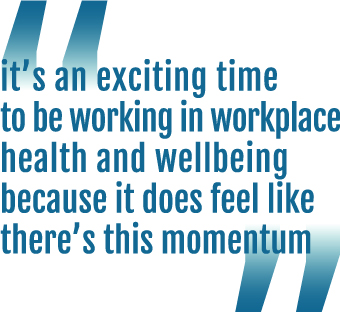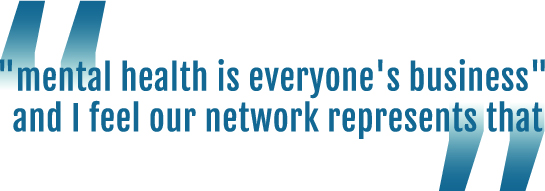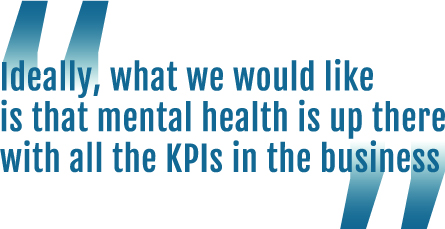Interview with Sharon Leadbetter – WayAhead Workplaces Coordinator

At WayAhead, we are lucky to work with some very keen minds, working on some very important issues. Before the WayAhead Workplaces Annual Members Forum, we had a chance to sit down with Sharon Leadbetter, the WayAhead Workplaces Coordinator, to have a chat about the program and the latest research and trends in mental health and wellbeing in the workplace.
Workplace wellbeing feels like it’s becoming increasingly important and that more people are talking about it. Is that actually the case and why do you think that is?

I do think that that’s the case, it’s an exciting time to be working in workplace health and wellbeing because it does feel like there’s a lot of positive momentum. When I started in the role four years ago, there were a few conferences a year at most on mental health in the workplace or wellbeing and now, the calendar is full. The other exciting thing is the amount of research coming out of Australia, focussed on workplace mental health or workplace health and wellbeing. The international research has always been really helpful and has guided a lot of people in Australia but to have research coming from your own country is really valuable.
I think there’s been a lot of good work done around promoting mental health and drawing attention to mental illness. There is a growing awareness of the statistics, an awareness of just how prevalent it is, and to battle the stigma that still exists quite strongly. I think there has been a lot more public discussion and public cases where well-known figures in the celebrity world or sporting world have experienced an illness and it’s become known and talked about and debated.
Then there are the facts and the stats about workplace health. You can’t escape the prevalence rates of mental illnesses in the community. It’s showing up in workers’ compensation rates, absenteeism and sickness. Even in things like the life insurance sector, it’s showing up through suicide statistics. People weren’t really connecting the dots and I think they are starting to now.
People are talking about it and putting programs into place, but are mental health and wellbeing programs really only something that larger corporations or the “big end of town” can pursue or prioritise?

Sharon Leadbetter – WayAhead Workplaces Coordinator
I can understand why people would think that and I will say that up to this point, from an Australian perspective, it has focussed on what I call “the big end of town” and that’s for reasons that are quite practical. They do have the money to actually look at, test and trial things. Testing and piloting the theories, approaches and programs is actually really valuable for the sector because we need to know what works and what doesn’t. They actually do provide a valuable resource to small or medium sized businesses. Where the trickiness comes in is the adaptability of the approach, but researchers are now getting better at recognising “one size fits all” is not the way. The tailoring of the message is quite important, recognising the different job sectors, different job types, workers who work indoors versus outdoors, isolated or in cities, there are so many nuances to workplace mental health, which is what makes it complex. Some themes are starting to emerge about what we know, what works or doesn’t.
In regards to small business, some of our contacts and researchers have been working behind the scenes on focus groups, researching and surveying small business communities and there’s going to be a rollout of some new resources. We recognise that there are some issues that are unique to small business, in particular, family-owned small business, where mental health is compromised not just because it’s their business but it’s their family – sometimes their house – is on the line and there’s a lot at stake for them, which makes their situations quite unique. There’s a lot of resources out there now, even in the four years that I’ve been here, a lot of places have been very generous in making them free or easily accessible or for a very small cost. And then there are networks like ours, organisations can join and be part of to get that wider support or some guidance to help them.
How can employers best support their staff who may be experiencing mental illness or distress?
There’s two parts to that question really. There’s the part of before someone does get ill and then there’s the part afterwards. The way I like to explain it is “life happens”, things happen to people and life gets hard and we need support. So we want workplaces to be thinking about it and looking at strategies, policies and processes around staff wellbeing. As employers, you have legal requirements but there are also things such as flexible work arrangements and reasonable adjustments available for employees to access. Are there things that can be tweaked or be made available to staff in case it’s needed? Do you have an employee assistance program for staff so that they’ve got somewhere to call? Are your managers and leaders trained to recognise when someone’s not doing so well? We don’t expect managers or leaders to be counsellors or psychologists, their job is to recognise when someone’s not doing so well and do something about it, and that’s creating effective referral pathways. That’s through HR, through your EAP or by having information that you can physically give people about local health services, websites and places you can refer them to. That way, you’re still being helpful, you’re still providing your duty of care but you’re not expecting to be the person that fixes their problem.
And then, from the other side of the coin, once someone is unwell, or perhaps they have to leave work for a time, looking at your return to work processes around helping bring someone back into the business. Research has shown that the previous approach of keeping people away from work for months at a time until they were 100 per cent well is actually not effective and doesn’t work. So there’s a real push to keep people in work, as long as that’s appropriate, and to start bringing them back earlier in a graded, phased return so that they still have the connection to their workplace, a sense of competence, a sense of independence and that financial security. Research also shows the importance of regular communication between the workplace and employee whilst they are on leave. Involving the person in that process to say “what will help you get back on track?” is important. You might have two colleagues who have been out of work with depression but their needs coming back could be quite different so you can’t assume it will be the same for everyone.
What does the ideal mentally healthy workplace look like? What are the outcomes we want out of a really well-rounded mental health and wellbeing approach in that case?
There is no ideal. It is aspirational because it’s not like any workplace is perfect or you have a mountaintop to get to and you think “right, we’re here.” It’s something a good organisation will be constantly reviewing and assessing and making adjustments on. The key factor is leadership, that the leaders are on-board, supportive and actively involved. That means talking about mental health, breaking the stigma around it, creating an environment which engenders trust (because disclosure will only happen when people feel that there’s trust), that they will be supported and listened to. Leaders are a huge part of creating the feel and the culture of a place. People disclosing can be a positive sign that you’re doing things well.

The leaders set the tone for an organisation – in regards to what is expected and acceptable behaviour – so investing in training your managers and supporting them to have those difficult conversations and recognise if staff aren’t doing well is important. To help them be brave and say “hey, are you okay? Do we need to talk?” We find a lot of workplaces are still going down the performance management route when they notice a change in someone’s work performance and they’re not stopping to think, “well, hang on a second, is that typical of this person? Has something changed in their life recently? Should I actually be asking some care and concern and welfare questions before I actually jump down the performance management route?” That’s what we advocate for because a lot of times, you’ll actually find that there are other things going on and there are reasons for that change in behaviour which can hopefully be addressed or supported. Mentally healthy workplaces also recognise people’s strengths and focus on what people are good at.
Research shows that the relationship between an employee and their manager is one of the most crucial in a workplace and influences a lot of the behaviour that will occur. I think for many organisations, conflict, misunderstandings or poor behaviour is accepted and tolerated and that can fester and lead to much bigger problems later down the track. I don’t think there’s enough recognition around the importance of dealing with those conflicts, to not be dismissive of them, taking people’s feelings seriously and making sure that the issues are adequately resolved. There’s a lot of factors, really, and like I say it’s not a “one size fits all”. The workplaces I see doing really well in this space are those that are willing to put their hand up and say “You know what? We’re not doing so well on this” or “I think we could be doing better” or “We actually don’t understand this and we need to get some help or some guidance on that”. They’re not afraid to admit they’re struggling with something. They don’t see it as a weakness, they don’t see it is a failing. They treat it as any other part of the business that needs their attention or may need to bring in specialists to help. Ideally, what we would like is that mental health and wellbeing is up there with all the KPIs in the business, it’s valued as much as all the other parts of the business, it’s championed by the top leadership level who are checking in on their deliverables in this area and that everything’s functioning okay. That then filters down into the way the business operates and they tend to find, in those organisations, that absenteeism drops, productivity increases, and its pretty hard to gauge creativity, but in the industries where they can gauge that, they notice increases in that as well.
Who are the kinds of people and organisations that you work with, through WayAhead Workplaces its programs?
What I love about our network is our diversity and I actually think it is one of our strengths that makes us interesting and relevant to our members. I jokingly say we’ll accept anyone and everyone, we don’t have a caveat on size of business, job title, job sector. We think it’s important to minimise as many barriers as we can for people accessing information and support around this issue because it’s an issue that affects everyone. Everyone’s in a workplace, everyone can think of good workplace and bad workplace stories. Our members are from a variety of sectors – law, education, government, health, not-for-profit – we’ve got small business, medium business, large, private sector.
 The network initially started as a place for human resource and occupational health and safety people but now – and I think this is a reflection of how this sector is growing – our membership includes return to work, injury management, health and wellbeing coordinators. We have psychologists, we have nurses, we’ve got researchers, which excites me. I think the phrase is “mental health is everyone’s business” and I feel our network represents that. The only caveat we put on someone signing up with that is that their job role must be to do with employee health and wellbeing. We have tiered pricing because we don’t like money being a barrier for people accessing services. We know of other networks out there; there are HR-specific networks or safety networks or government-sector networks but we haven’t come across any others like ours.
The network initially started as a place for human resource and occupational health and safety people but now – and I think this is a reflection of how this sector is growing – our membership includes return to work, injury management, health and wellbeing coordinators. We have psychologists, we have nurses, we’ve got researchers, which excites me. I think the phrase is “mental health is everyone’s business” and I feel our network represents that. The only caveat we put on someone signing up with that is that their job role must be to do with employee health and wellbeing. We have tiered pricing because we don’t like money being a barrier for people accessing services. We know of other networks out there; there are HR-specific networks or safety networks or government-sector networks but we haven’t come across any others like ours.
Why do you think WayAhead has taken on this specific role of working with organisations and employers in tackling having better mental health in the workplace?
The program is eleven years old this year and when we had our tenth birthday last year, I tracked down all the people who have had this job and I’ve actually met everyone who has been the co-ordinator for this program so I’m in a very unique position. I asked the lady that started it, expecting some very thoughtful answer about why, but it wasn’t. The charity was just getting enquiries from workplaces around mental health issues and they were struggling to know what do with it and how to do it. They thought “well, why don’t we just have a meeting and see if we can help?” So it started as simply as that and a lot of our programs here at WayAhead, from what I understand of our history, have started like that, with people who just cared or people who thought “well, let’s try something”. I was quite proud to know that the Workplace program was around right at the beginning when all the other big players were starting this work too. We have just been a bit more under the radar. I’d say the reason we’re still doing it, the reason the project’s grown, is because of the recognition of the impact mental health issues and illness has on the community. The research shows that if we invest in our mental health and wellbeing, then we can actually have healthy, happy and productive lives as people, so it becomes a people issue, not just a workplace one, which I really like.
By Tasnim Hossain
Top 5 ways organisations can support their employee’s mental health – By Sharon Leadbetter
Newsletter
Stay up to date
Sign up to our Mind Reader newsletter for monthly mental health news, information and updates.
